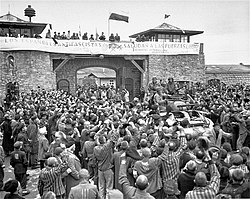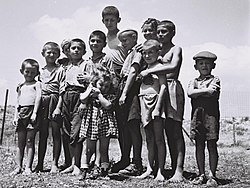
A Holocaust survivor is a person who survived the Holocaust perpetrated by the Nazis, which occurred during World War II. Every person who lived in a country under Nazi rule from the outbreak of World War II in Poland in 1939 until the liberation of Europe in May 1945, including those who were imprisoned in camps of every kind, is considered a survivor. All Jewish citizens living under Nazi occupation suffered from varying degrees of persecution, whether it was displacement from their homes into overcrowded ghettos, forced transportation, slave labor in labor camps, or suffering physical, mental, and emotional harm due to inhumane conditions, horrific violence, and extreme cruelty in areas either under direct control of the Nazi regime or its collaborators.[1] Many Holocaust survivors lost loved ones during the war, some even remaining sole survivors from entire families or communities that were exterminated as a result of the Nazi genocide.
Yad Vashem, the State of Israel's official organization responsible for memorializing the victims of the Holocaust, defines Holocaust survivors as Jews who lived under the direct or indirect control of the Nazi regime and survived it. This definition covers also Jews who fled their home countries to evade the advance of the German army, Jews who were force to flee Germany upon the rise of the Nazis, and Jews who spent the entire war living under Nazi collaborationist regimes, including France, Bulgaria and Romania, but were not deported.[2]
Research your ancestors on MyHeritage
Researching Holocaust survivorsResearching Holocaust survivors
Jewish families living in Europe before the war were generally large in size, with the average family having between six and ten children; families with 15 children were not rare; it should be noted that in most of these cases, they were not from the same mother, but from the same father, as the percentage of women who died in or shortly after childbirth was higher than it is today, due to lack of access to adequate medical care in the event of a complication. The widow, who often was unable to take care of the newborn on his own, would often remarry quickly, bringing in a younger woman who could help him care for all his children. The new wife would often want children of her own, and the family would grow to include a large number of children.[3] Due to this family structure, it can sometimes be difficult to find all the family members, whether because they took different surnames, or because even the survivors don't know or remember the names of all of their extended family members murdered in the Holocaust.
In most cases, the survivors were the youngest members of the family, whom the Nazis allowed to live so they could take advantage of their labor. The Nazis considered a person over the age of 45 old, and people who were above this age would be sent to their deaths immediately. The average age of the survivors was usually between 18 and 25, and survivors aged 30+ were rare. Younger family members are less likely to remember the older generations, so their memories were not always accurate.
Child Holocaust survivorsChild Holocaust survivors

See also: Youth Aliyah
One special category of Holocaust survivors is the one made of those who were children at the time of the war. Most of the Jewish children found after the Holocaust were found hidden in monasteries, with partisans, in the forests, with non-Jewish families whose parents gave them up for safekeeping, or simply wandering alone. Because young children tend to get attached to the adults taking care of them, sometimes parents had a hard time retrieving their children from these settings, either because the child didn't want to leave them or because the hosting families did not want to give them back after developing affective bonds.[4] Survivors who were young children rarely remembered the names of their siblings or other family members; sometimes they did not even know their own given names, which presents a major obstacle to reconstructing a family tree. Orphaned children who arrived in Israel were immediately sent to the youth aliyah institutions or institutions of the Mizrahi movement.[5]
Researching Holocaust survivorsResearching Holocaust survivors
The biggest advantage Holocaust researchers have is that the Nazis were extremely meticulous in their record-keeping,[6] which means that documents they created about one person often contained information about additional family members as well; one very important recommendation is to avoid searching by the Hebrew name of the person and use the "secular" name instead and use Latin characters, perhaps except in Yizkor books.
Records of Holocaust survivorsRecords of Holocaust survivors
- Yizkor Book Name Index from JewishGen at MyHeritage
- Sharit haPlatah, Holocaust Survivors from JewishGen at MyHeritage
- Jewish Holocaust Memorials and Jewish Residents of Germany 1939-1945 at MyHeritage
- Yad Vashem: The World Holocaust Remembrance Center
- Arolsen Archive in Germany: International Center on Nazi Persecution
- The Auschwitz-Birkenau archives: It is possible to search according to the numbers tattooed on the survivor's arm.
ReferencesReferences
- ↑ Rozett, Robert; Spector, Shmuel (2013). "Holocaust survivors". Encyclopedia of the Holocaust. Taylor & Francis. pp. 427–428. ISBN 978-1-135-96950-9.
- ↑ FAQs - Names’ Database. Yad Vashem
- ↑ Ofer, Dalia. Family During the Holocaust. Jewish Women's Archive
- ↑ HIDDEN CHILDREN: QUEST FOR FAMILY. Holocaust Encyclopedia - United States Holocaust Museum
- ↑ Kadosh, Sara. YOUTH ALIYAH POLICIES AND THE RESCUE OF JEWISH CHILDREN FROM EUROPE 1939-1942. World Union of Jewish Studies. 1997
- ↑ Revisiting The Horrors Of The Holocaust. CBS News

